Are you using AI coding assistants such as GitHub Copilot, ChatGPT, or Google Gemini to speed up development?
These tools accelerate workflows, simplify debugging, and even generate complete functions from simple prompts. However, they also introduce challenges around originality, software security, and license compliance.
To address these concerns, many professionals now rely on an AI code detector. It can analyze source code, identify AI-generated patterns, and highlight potential risks like hidden vulnerabilities or unoriginal submissions.
In this article, we’ll look at the best AI code detector tools available today and how they help developers and organizations maintain code quality and integrity.
Eduma – Education WordPress Theme
We provide an amazing WordPress theme with fast and responsive designs. Let’s find out!
Why You Need an AI Code Detector
Before we dive into the specific tools, it’s important to understand the value an AI detector code solution brings. Whether you are a solo developer, part of a large enterprise, or an educator, these tools offer significant benefits:
- Enhancing Code Quality: AI models can sometimes produce code that is functional but inefficient, or that doesn’t follow project-specific conventions. A detector helps flag these sections for human review.
- Improving Security: AI-generated code may inadvertently introduce security flaws. By identifying these snippets, developers can perform targeted security audits.
- Protecting Intellectual Property: Using AI-generated code without understanding its training data can lead to licensing conflicts. A detector helps organizations enforce policies around the use of AI tools.
- Upholding Academic Honesty: For universities and coding bootcamps, an AI code detector is essential for ensuring students are developing their problem-solving skills rather than relying solely on AI to complete assignments.
Comparison Table: Best AI Code Detector Tools
| Tool | Accuracy Rate | Supported Languages | Best For | Key Features | Pricing / Access |
| Copyleaks | 99%+ | 30+ human & coding langs | Enterprises & Education | AI + plagiarism detection, API, SOC 2, GDPR | Paid, free trial |
| Codespy.ai | ~98% | Java, Python, JS, C++, C#, PHP | Dev teams & software managers | IDE integration, error pattern recognition, team workflows | Paid plans |
| CodeDetector.io | 99% claimed | All major AI models (ChatGPT, Gemini, Claude) | Solo developers & small teams | Web-based, instant results, free tier available | Free & Premium |
| Originality.ai | High (esp. text+code) | Mixed text + code content | Writers, educators, devs mixing prose & code | Plagiarism checker, team management, API | Paid scans |
| GPTZero | Moderate–High | Text + code structures | Educators & academics | Perplexity/burstiness analysis, API, Google Docs integration | Free & Premium |
| Poe AI-Code-Detector | Likelihood-based | Various (focus on AI patterns) | Educators & casual users | Explains results, simple UI, instant feedback | Free |
The Best AI Code Detector Tools
Navigating the market for the right tool can be challenging. We have analyzed and compiled a list of the most reliable and feature-rich AI code detectors to help you make an informed decision.
1. Copyleaks
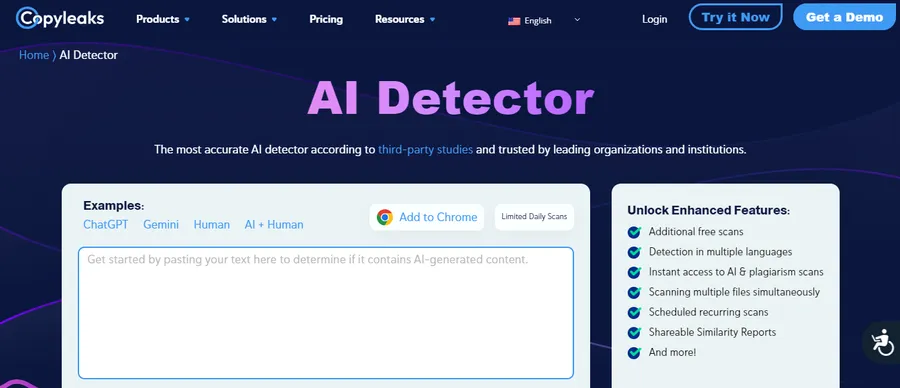
Copyleaks has established itself as a comprehensive solution for content integrity, extending its powerful detection capabilities to source code. It is not just a text detector but a multi-faceted platform trusted by enterprises and academic institutions alike.
Copyleaks offers a robust, all-in-one platform that combines AI detection with plagiarism checking. Its AI-generated source code detection feature is specifically trained to identify patterns unique to code generated by models like ChatGPT, Gemini, and Claude. Its emphasis on enterprise-grade security and seamless integration makes it a top choice for organizations that need a scalable solution.
Key Features
- High Accuracy: Boasts over 99% accuracy with a very low false positive rate (0.2%), ensuring reliable results.
- Broad Language Support: Detects AI-generated content across more than 30 human languages and numerous programming languages.
- Seamless Integrations: Offers API access for custom integration and works directly with Learning Management Systems (LMS), making it ideal for building a robust educational platform.
- Advanced Security: Features military-grade security, GDPR compliance, and SOC 2 certification, ensuring your data remains protected.
- Comprehensive Detection: Capable of identifying interspersed AI content, where human-written and AI-generated code are mixed.
2. Codespy.ai
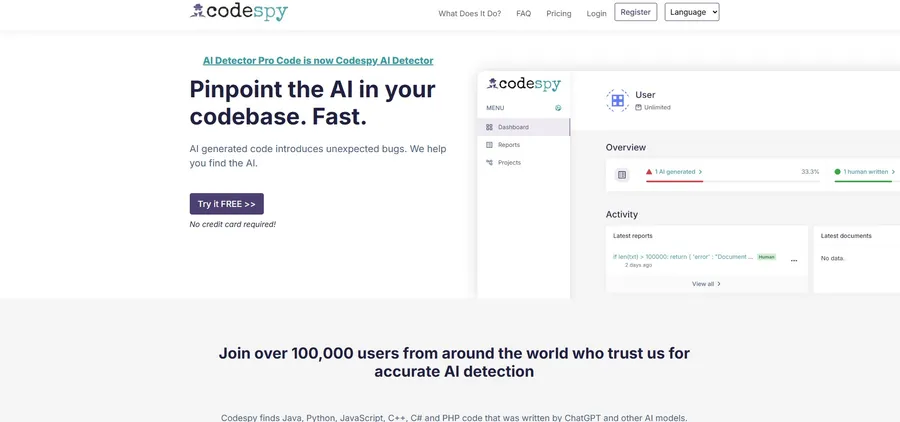
Codespy.ai is a specialized tool designed from the ground up as a dedicated AI detector for code. Its sharp focus on developers and software teams makes it a highly practical solution for professional environments.
Formerly known as AI Detector Pro Code, Codespy.ai positions itself as a critical assistant for software managers and development teams. It helps organizations establish “guardrails” for using AI in coding, allowing them to innovate faster while mitigating risks. It pinpoints AI-generated code, enabling engineers to review and correct potential errors before deployment.
Key Features
- Specialized for Code: Optimized to detect AI-generated code in popular languages, including Java, Python, JavaScript, C++, C#, and PHP, with a 98% accuracy rate.
- Developer Tool Integration: Integrates directly into common development environments like Visual Studio Code and is even available as a ChatGPT plugin.
- Team-Oriented Workflow: Designed to improve code reviews and help teams develop internal processes for responsible AI adoption.
- Error Pattern Recognition: Helps teams understand common error patterns in AI-generated code, enabling them to create better development guidelines.
3. CodeDetector.io
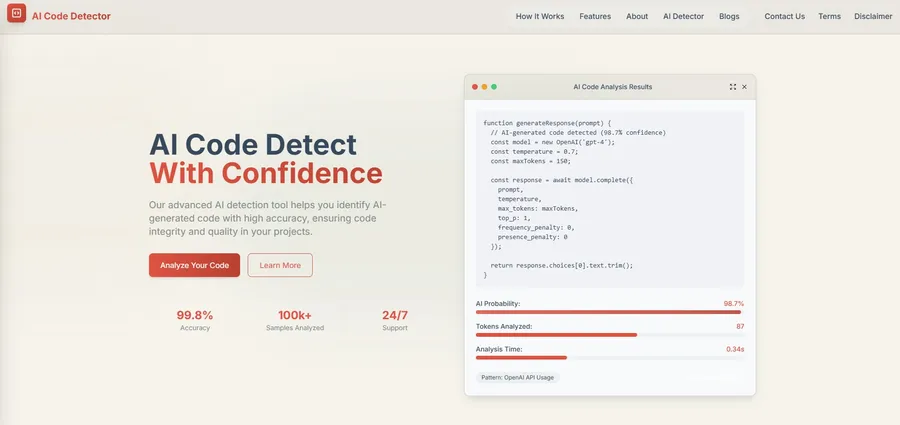
For those who need a quick, accessible, and highly accurate solution, CodeDetector.io offers a straightforward and powerful platform. Its simplicity does not compromise its effectiveness, making it a favorite among individual developers and small teams.
CodeDetector.io provides a clean, web-based interface where users can simply paste their code and receive an instant analysis. The tool claims an impressive 99 % accuracy rate and is trained to identify code from all major AI models, including the latest versions of ChatGPT and Gemini. Its free tier makes it an excellent entry point for anyone curious about the origins of a piece of code.
Key Features
- Exceptional Accuracy: Claims a market-leading 99 % accuracy rate in distinguishing between human and AI-written code.
- User-Friendly Interface: The online tool is incredibly easy to use—just copy, paste, and analyze.
- Free Access: Offers a free version for immediate analysis without requiring a sign-up, making it highly accessible.
- Broad Model Support: Specifically trained to detect code patterns from ChatGPT, Gemini, Claude, and other large language models. This makes it a very capable AI detector code tool.
- Fast Analysis: Delivers analysis results in seconds, providing a confidence score and highlighting potential AI patterns.
4. Originality.ai
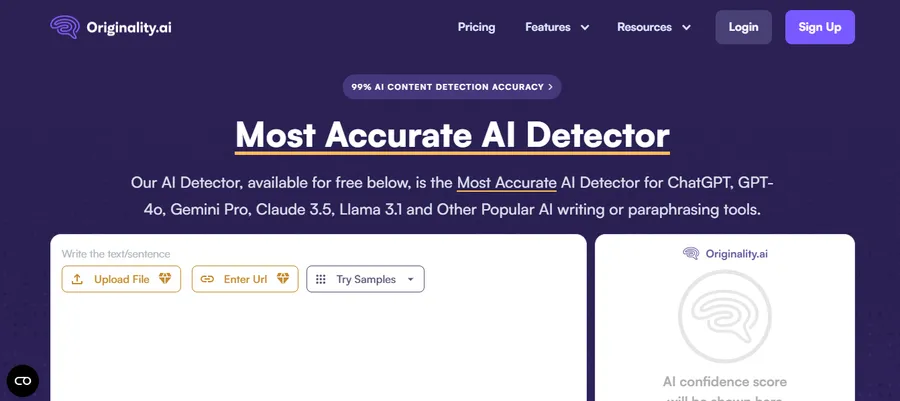
While widely known as an AI detector for writers and content marketers, Originality.ai also possesses formidable capabilities for detecting AI in code snippets and technical documentation. It is an excellent choice for users who work with a mix of prose and code.
Originality.ai is built for professionals who demand high accuracy. It is designed not only to detect AI but also to check for plagiarism. While not a dedicated code.ai detector, its sophisticated model is effective at identifying AI patterns in code, especially within technical articles, tutorials, or student assignments that mix explanations with code blocks.
Key Features
- High Accuracy on Mixed Content: Excels at scanning documents containing both text and code, providing a holistic originality score.
- Plagiarism Checker Included: The built-in plagiarism scanner adds another layer of content verification.
- Team Management Features: Allows users to manage team members and track scan history, which is useful for content and development teams alike.
- API Access: Provides API access for integrating its detection capabilities into your own workflows and applications.
5. GPTZero
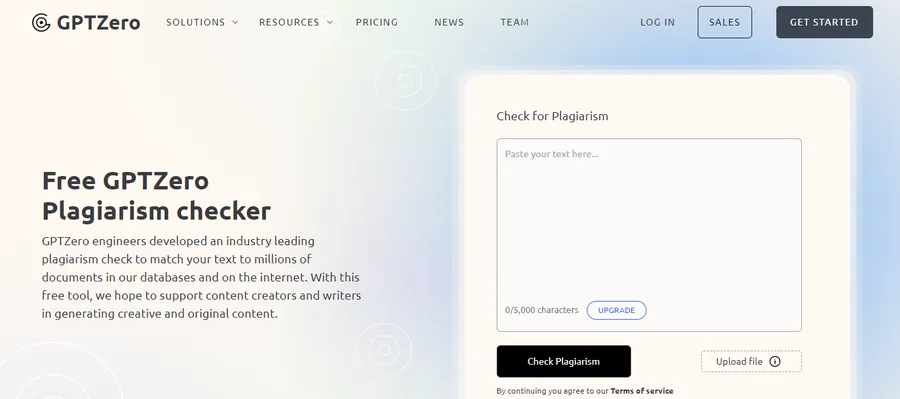
GPTZero started as a student project and quickly grew into one of the most recognized names in AI detection. Originally focused on essays, it has since expanded its model to better handle a variety of content types, including code.
GPTZero is widely used in academia but also serves professionals. Its model analyzes text for perplexity and burstiness—metrics that often differ between human and AI writing. While it is not marketed as a specialized AI code detector, its underlying technology can effectively flag code that has a machine-generated structure and predictability. It is best used for academic assignments or documentation where code is part of a larger text.
Key Features
- Focus on Educational Integrity: A leading choice for educators to check student submissions for AI-generated content.
- Detailed Analysis: Provides sentence-by-sentence highlighting, showing which parts of the text are likely generated by AI.
- API and Integrations: Offers an API for large-scale use and integrates with tools like Google Docs.
- Free and Premium Tiers: Provides a free version for casual use and premium plans for higher volume and advanced features.
6. Poe AI-Code-Detector
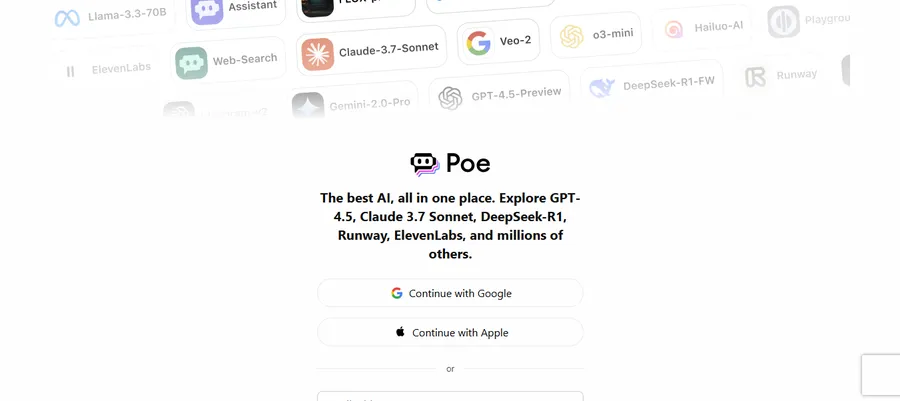
For educators, developers, and anyone curious about code originality, AI-Code-Detector on Poe provides a simple yet insightful way to check whether a piece of code may have been generated by AI. Instead of giving a plain yes/no result, it explains the reasoning behind its findings, making it an excellent tool for learning and evaluation.
AI-Code-Detector analyzes code for subtle patterns such as overly consistent formatting, uniform naming conventions, or other hints of machine generation. It then provides a likelihood-based assessment, helping users understand the “why” behind the detection. While not perfect, it is a valuable aid for promoting honesty in coding tasks and saving time during reviews.
Key Features
- Explanatory Analysis: Goes beyond a simple verdict by explaining why the code might appear AI-generated.
- Likelihood-Based Results: Provides probability-style feedback instead of black-and-white answers.
- Educator-Friendly: Especially useful for teachers checking student assignments for originality.
- Accessible & Simple: Clean interface makes it easy to paste code and get instant insights, even for non-experts.
- Helpful Guidance: Encourages transparency by showing potential AI patterns without overclaiming 100% accuracy.
FAQs
1. How does an AI code detector actually work?
An AI code detector works by using a machine learning model trained on vast datasets of both human-written and AI-generated code. The model learns to recognize subtle statistical patterns, structures, and artifacts characteristic of AI generation. For example, AI-generated code might exhibit lower "perplexity" (less randomness) and more consistent patterns than human code, which is often more varied and idiosyncratic. The detector analyzes these features to calculate the probability that a given piece of code was written by an AI.
2. Can an AI detector for code be 100% accurate?
No AI detector can guarantee 100% accuracy. The nature of generative AI means there will always be a possibility of false positives (flagging human code as AI) and false negatives (missing AI-generated code). The best tools, like those listed above, achieve very high accuracy rates (over 98-99%), but their results should always be used as a strong indicator, not as definitive proof. Human oversight and review remain critical.
3. Is it unethical or illegal to use AI-generated code?
The ethics of using AI-generated code depend on the context. In a professional setting, it is generally acceptable if it complies with company policy and the code is thoroughly reviewed, tested, and secured. However, using it can become unethical or illegal if it violates software licenses (as some AI models are trained on copyrighted code) or if it is used to circumvent security policies. In academia, submitting AI-generated code as one's own work is almost always considered plagiarism.
4. Which programming languages can these detectors analyze?
Most specialized AI code detectors, like Codespy.ai and Copyleaks, support a wide range of popular programming languages, including Python, JavaScript, Java, C++, C#, PHP, and more. General-purpose AI detectors that also handle code can analyze syntax across many languages but may be most effective with the most common ones found in their training data.
5. Can I use a regular AI text detector for code?
While a standard AI text detector might flag some AI-generated code, it is not optimized for it. Code has a fundamentally different structure, syntax, and statistical properties than natural language. A specialized AI detector for code is trained specifically on source code datasets, enabling it to more accurately identify AI-generated programming patterns, making it a far more reliable choice for developers and engineers. It's a key part of maintaining modern web development best practices.
Read more: 10 Best WordPress Plugins for Education Websites
Contact US | ThimPress:
Website: https://thimpress.com/
Fanpage: https://www.facebook.com/ThimPress
YouTube: https://www.youtube.com/c/ThimPressDesign
Twitter (X): https://twitter.com/thimpress


